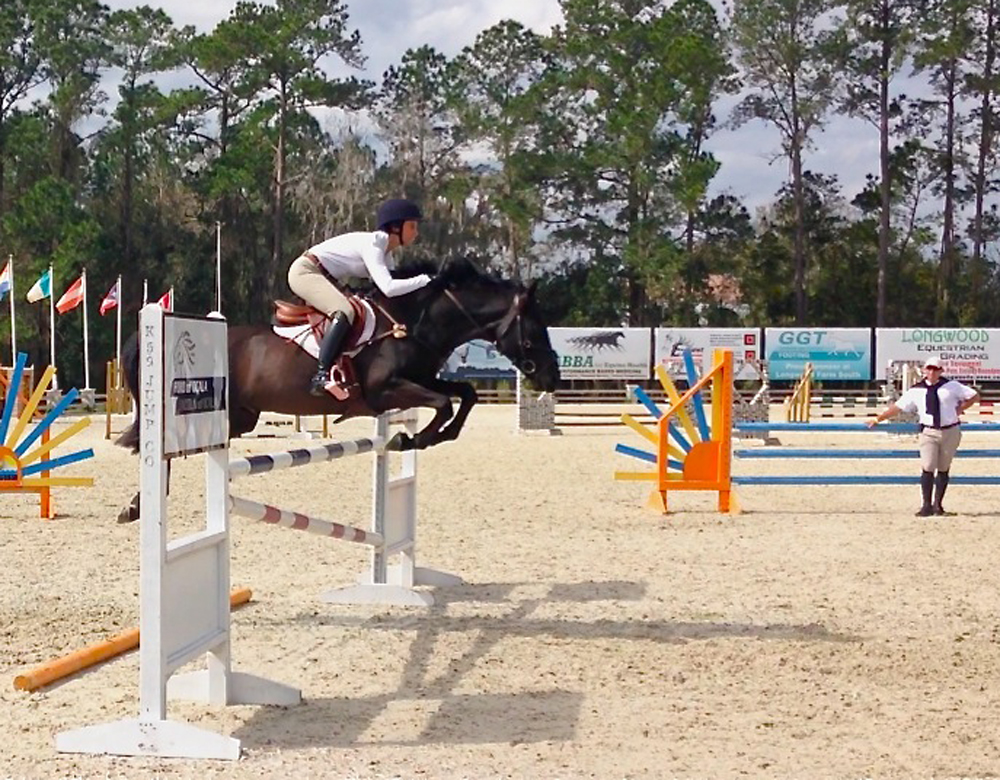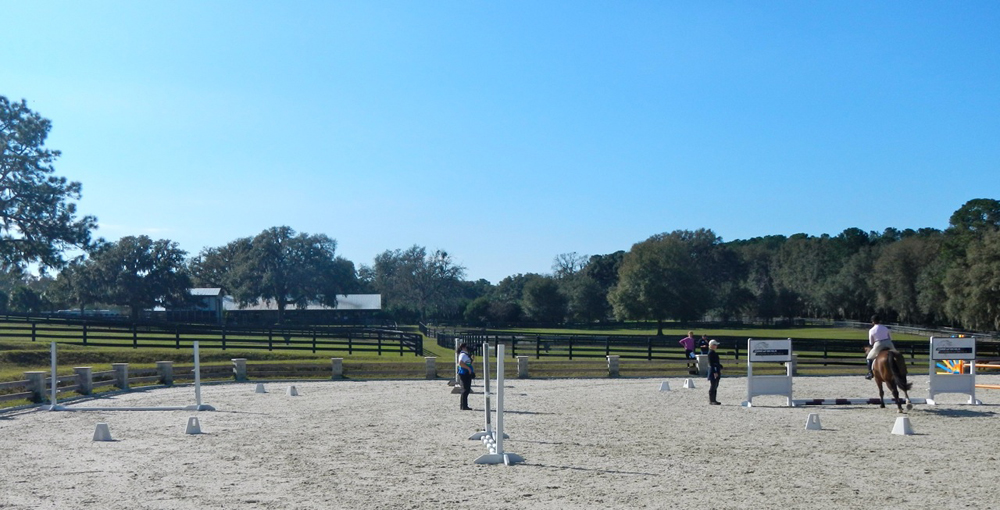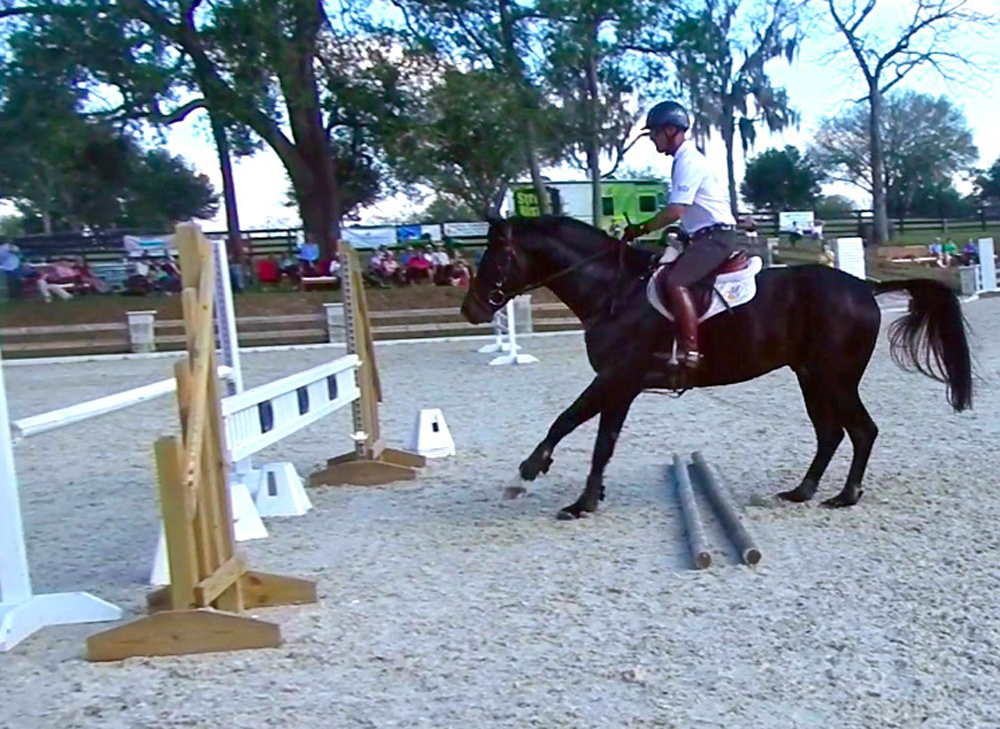The second day of the U.S. Eventing Association’s Instructors’ Certification Program Ocala Symposium featured grand prix show jumper Aaron Vale.
While Vale showed riders some useful exercises and made corrections, he conducted the day more as a clinic. The purpose of the ICP is to educate trainers in different systems and approaches to teaching. Sue Hershey, one of the initiators of the ICP and an ICP committee member, said the program’s goal is “to invite presenters to share and explain as much to the audience as to the riders about how and why they are making their teaching decisions.”
On that account, Vale seemed to fall short. Those in the audience were left more as clinic spectators than involved and informed instructors. Vale was a man of few words and tended to let the exercises and repetition educate the horses and riders.
With countless accolades as a rider and trainer to his name, Vale surely has a system of training and theory he follows, but he struggled to articulate it explicitly throughout the day. His style was laid back and humorous, his exercises demanding, and his instruction short but pointed.
The day began with a theory session, where the presenter is encouraged to lay out the system they follow in producing horses and riders. Vale thought a minute and said, “Everyone’s aim in any sport is to get the most out of the horse. For me, too, I want to get the best out of my horses.” When prompted to expand he laughed and said, “Well, I guess I have a short philosophy!” He likened a horse’s jump technique to a golf swing, and said his goal is to teach the horse a consistent jumping effort so that it can handle mistakes on course.
An attendee asked about creating partnerships, and Vale said that for him a partnership is about confidence and trust. He said the important thing is to have a good program and let it develop. He reminded riders not to be in a rush, stating that “everyone wants to do higher, but you need a solid foundation or when you do higher the bricks will fall out the bottom.”
 |
| “Always wait,” was Aaron Vale’s advice about approaching a jump, as Rebecca Brown is doing.. Photo by Kristin Carpenter |
Always Wait
Over the course of the day, the various groups of riders and horses tackled four main exercises. Vale had everyone begin by trotting a set of rails with guide rails after to force straightness. Once they had trotted the first set of rails, they would then leg yield left or right until aligned with a second set of trot rails. In later groups, this same exercise was started at canter with a vertical, leg yield left or right to the second vertical.
The two main principles he wanted in this exercise were correct lateral movement in the leg yield, and “forward at the beginning, waiting at the end.” He would prompt riders to not “just turn” between the two fences, but to keep the horse straight and move the hind end over.
For all riders and types, he would ask the six strides to become seven or even eight, making the horses wait and add at the end.
The second exercise was, in the early groups, a line of two verticals set at six or seven strides. He would ask the riders to jump it in six strides, then return and jump it in seven. For later groups, it was a line of three verticals with 60 feet between them each. He would ask riders to jump it in five strides to five strides, then four strides to five strides.
While there were a variety of horses, approaches, techniques, etc., Vale’s feedback for everyone centered on a couple basic principles. He encouraged many riders to come in “faster,” so that they could “settle instead of chase down the line.”
While many riders would approach in a shorter canter if they knew they needed to add a stride in the distance, Vale wanted horses to have the ability to come quickly and powerfully through the turn and to the first fence. He explained that, “Fast breeds anticipation in the horse,” but horses must be disciplined in the use of their body and shoulder alignment and learn to “rock back” and hold themselves off the fences.
The second major principle of the exercises seemed to be to always add at the fences. “If you have a choice,” he explained, “put one more step. Always wait.”
ADVERTISEMENT
The Circle Of Death
 |
| Aaron Vale used the infamous Circle of Death exercise to help riders practice riding a specific track. Photo by Kristin Carpenter |
Throughout the day there were a couple horses that were not yielding to the riders’ half-halts and either taking a bit of a flyer at the last fence or adding an uncomfortable chip stride and jumping awkwardly.
Vale would encourage the riders to get the half-halt earlier, and have them repeat the line until the correct striding was achieved. He did not adjust the technique of their half-halt, approach to the jump, canter quality or stride, rider position, or other variables, instead electing to have the exercise and repetition teach the riders.
For those watching to learn how to teach, Vale was an example of a trainer using exercises he is familiar with and waiting on a result he expects through repetition.
The third major exercise Vale humorously called “The Circle of Death.” The exercise was composed of four rails placed equally around a circle. For the first groups, they had a pair of cones at the point of turn between each rail. Vale asked the riders to canter their first circle by going on a track outside the cones, then the second circle to track through the cones, the third circle to track inside the cones, and the last circle to track outside the cones again.
For the later groups, the cones were removed and Vale required riders to complete the circle with six strides between each rail, then five strides, then four strides, then back to six. For all groups, the rails were raised to verticals after each horse had gone once each way.
The exercise allowed Vale to stress the importance of track. “I’d prefer to slow the speed and preserve the track,” Vale told riders, “I am all about the track.”
Many riders struggled with this exercise, and Vale reminded them, “a jump is just another quality canter stride.” After the horses and riders navigated the Circle of Death a few times, Vale would have them complete three parts of the circle to the right, then turn left away from the circle and jump a vertical. For some groups, they would do this small course and then come to the line of three verticals at 60 feet, completing it in four strides to five strides.
Let The Jumps Do The Work
For the morning groups, those exercises completed their lesson. For the more advanced evening groups, he added gymnastics at the end. The first gymnastic set was two vertical bounces at 9 feet, then 19 feet to a vertical, then 30 feet to an oxer. In front of the oxer, however, Vale set two poles together at 7 1/2 feet from the ground line.
 |
| Joe Meyer practices over the two rails set at 7 1/2 feet out from the jump to make the last stride short and quick. Photo by Kristin Carpenter |
Vale stated that he used two poles because they are easier to see for the horses, and he placed the poles at 7 1/2 feet because he wants the last stride before the jump to be short and quick.
The first principle of the exercise was Vale’s desire for a compact final stride. After a few riders went, he stressed that for the last two strides to the oxer, the riders are to push for the first stride so it is longer and the horses don’t have to “reach” to cover the poles in the second stride.
He pointed out the hoofprints to the audience, stating that the final stride before the oxer, when ridden correctly, was only about a 6 1/2-foot stride. This is what Vale wanted for the horses to be able to lift their shoulders and quicken their front end.
A few of the horses struggled to maintain technique out of such a short stride, and Vale encouraged them to continue coming back through the exercise. One horse had four or five times through before he finally achieved a quality jump at the oxer. Vale was happy with that, and it displayed his methodology that the exercises and repetition will educate the horses and riders.
ADVERTISEMENT
The second major principle was the horse learning to hold itself off the jump. He told riders that were half-halting during the gymnastic to “let the jumps do the work,” and not to use their hands to “lift the horse off the fences.”
Over time, he explained, he would increase the speed at which he approached the gymnastic, until it was built up to a gallop. He stated, “I want to be able to gallop in and have the horse hold themselves back, but you have to build up to that.”
This principle was echoed in the two-stride, when he would encourage riders to kick forward on the first stride to achieve a short second stride instead of riding for an equal two strides in the gymnastic.
No Explanation Needed
Vale has an engaging personality and a charm that carried riders through the lessons. As the day went on, he seemed to be trying harder to explain why he was choosing certain exercises and what he hoped to achieve.
In general, however, for instructors that came hoping to glimpse how Vale dissects horses’ jumping techniques and riders’ style and effectiveness were left wanting. At the lunch question-and-answer session, one attendee asked Vale what exact homework he would give two horses in the group with vastly different techniques. Vale said that the exercises he built for the ICP Symposium are the exercises he does at home every week, so he would continue them for both horses, working to improve adjustability.
While some were frustrated with the general nature of the comments, I can only think that Vale’s program is so solidified that he has created exercises he feels achieve the priorities he wants in technique, no matter the horse.
Everyone left with a series of exercises they can set up at home, and a clear understanding of his priorities for each exercise, even if it wasn’t the encyclopedia of analysis they were expecting. In the end, Vale seemed to approach things with a few simple priorities, and perhaps simple is best.
The U.S. Eventing Assocation Instructor’s Certification Program seeks to add to the knowledge base of all eventing instructors. Symposiums are a part of the continuing education for ICP instructors.
Read coverage of the first day of the USEA Instructor’s Certification Program Ocala Symposium, which featured teaching by Grand Prix dressage rider Jacqueline Brooks.















